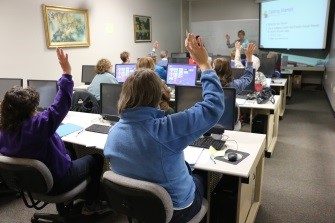For Students Who Need Learning Accommodations The Process Works Differently After High School
High school students who receive accessible educational materials and other learning accommodations during high school will find the process for putting these supports in place changes once a student transitions to college or post-secondary education settings.
Self-Advocacy matters and should begin early. Teachers, related services personnel, guidance counselors, and librarians can support students as they learn to explain the supports that they need during K-12 years. The professionals also can be a support as students plan to secure the accommodations for learning after high school.
Academic Accommodations
"College accommodations are those supports and services provided at no cost to eligible students with disabilities to have equal access and opportunity to benefit from classes, programs, and activities," according to Virginia's Center for Transition Innovations at Virginia Commonwealth University. Here is the staff's short list of academic considerations:
- Priority registration
- Note takers
- Extended time on tests
- Testing in a limited distractions room
- Accessible classrooms
- Interpreters, and
- Textbooks [and other learning materials] in an alternate format
Self-Advocacy For Accommodations
Knowing how to request and use the accommodations "can make a big difference in student learning and grades achieved," the Center writes in "College Accommodations." The key differences between high school and college are significant. Without understanding that there is advance work to be done, students who need accommodations after high school run the risk of losing ground in the first weeks of school as they scramble to put the services in place.
Students in K-12 settings are entitled to accommodations under the Individuals with Disabilities Education Act. In college, however, these support services must be requested in advance and students must prove they are eligible for them under either the Americans with Disabilities Act or the Rehabilitation Act of 1973.
Transition Made Easy
A chart, "College Accommodations," spells out the differences so educators and parents can support students so they:
- Know where to go for support services
- Have the required documentation to submit, and
- Take necessary steps to put them in place.
That process involves registering, filling out forms, talking with a disability coordinator, and giving accommodation letters to professors. Find additional tips in the publication to make the process go smoothly.
Resources
- The Center on Innovative Transitions at VCU This must-view website offers information about transitions topics, training, publications and other resources.
- Moving Ahead (Association on Higher Education and Disability®) – Transition Resources for Everyone AHEAD, a membership organization for helping professionals, offers an array of resources on the successful transition of students with disabilities to, through and beyond college. Log on to FAQ’s - Students, FAQ’s - Parents and Transition Resources A – Z.
- The National Center for College Students with Disabilities (NCCSD) A clearinghouse of information and resources found here are designed for future and current college students and their families.
- DREAM (Disability Rights, Education Activism, and Mentoring) This national organization exists for and by college students with disabilities to advocate for disability culture, community, and pride in higher education,
- Eye to Eye This innovative mentoring program supports students labeled with language, reading, and math based learning disabilities (LD) and/or attention deficit hyperactivity disorder (ADHD). A network of 50 local chapters includes colleges and universities and is a possible resource for mentors to share their personal stories of how they put accommodations in place after high school.
We Are AIM-VA
Accessible educational materials (AEM) help to create access to the curriculum for students with dyslexia, learning disabilities, vision or physical challenges, and others. A federally funded AEM program in every state assures that books in alternative formats are provided free of charge to eligible students with disabilities whose education teams take action. The AEM program operates under a legal exception to federal copyright law. Check out the AIM-VA home page to learn more about eligibility in Virginia. In other states, contact a special education teacher, a school administrator or download a list of AEM state contacts.![]() .
.
Follow AIM-VA on Facebook ![]() , Pinterest
, Pinterest ![]() , and Twitter at @AIMVirginia.
, and Twitter at @AIMVirginia.![]() and/or follow me @aimnoncat.
and/or follow me @aimnoncat.![]() . Subscribe to AIM-VA's new monthly newsletter. Sign up here.
. Subscribe to AIM-VA's new monthly newsletter. Sign up here.







